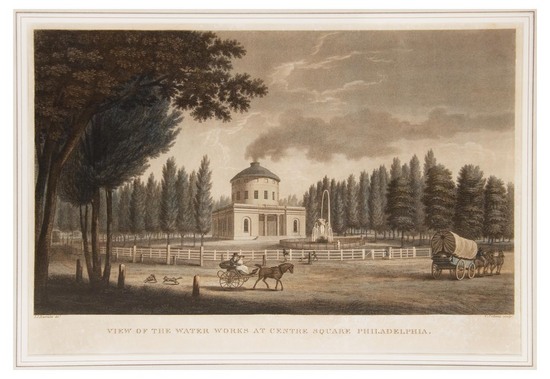
Dilworth Plaza sculpture pays homage to first citywide water system
By Linda Harris, Center City District Philadelphia Janet Echelman determined to create moving columns of atomized water for her public sculpture Pulse after delving into the history of Philadelphia’s Centre Square, one of William Penn’s original five squares. Echelman’s unique work, to be showcased in the $50 million transformation of Dilworth Plaza adjacent to City Hall, is a direct reference to the site’s long-standing association with water, especially the history-making pump house of the Centre Square Water Works, which began operating in 1801on the site where City Hall now stands. Echelman’s atomized water, illuminated by colorful LED light, mimics steam mist, a tribute to the steam engines used to pump the water and, later, the steam-driven trains arriving at and departing from the Pennsylvania Railroad station located directly across the street.
The Centre Square Water Works was designed by Benjamin Henry Latrobe and was completed in 1801 on the site where Philadelphia’s City Hall now stands.
In the late 18th century, Philadelphians were struggling with recurring bouts of Yellow Fever, especially the epidemic of 1793, which killed about 10% of the city’s population. The disease and filth of the city caused the citizens to demand a solution, and leaders formed a “watering committee.” Clean water for drinking and for cleaning had become a top priority.
British-born architect Benjamin Henry Latrobe was commissioned to create a way to distribute water to the city. Latrobe designed a handsome neoclassical pump house, to be built in Centre Square. The water pumps used steam engine technology, cutting-edge science at the time. The first pump moved water out of the Schuylkill River via a tunnel and the second helped distribute it throughout the city. Latrobe also created a network of wooden pipes that followed the street patterns so that residents could connect to the pipes to access the water. Philadelphia thus became the first city in the country to establish a comprehensive water-delivery system.
The steam engines proved expensive, temperamental and unreliable, often breaking down and disrupting the water supply. The Centre Square Water Works lasted only about a decade, but it was an important first step in the wholesale distribution of fresh water to the citizenry and was the forerunner of the more enduring Fairmount Water Works, still in existence, now as a museum, on the Schuylkill River. Latrobe went on to help engineer the building of the Chesapeake and Delaware Canal.
Janet Echelman’s sculpture, with its reference to this historic turning point in the management of water to improve people’s daily lives, will establish Dilworth Plaza among the great public places in the country. Well known for reshaping urban space with large suspended woven structures that respond to environmental forces, Echelman was inspired by Centre Square’s historic narrative and charted a new path of expression.
Commissioned by the Center City District, Echelman’s first work using moving curtains of illuminated atomized water will be integrated into Dilworth Plaza’s new, 11,600-square-foot fountain. The moving five-foot-tall curtains of mist will trace above ground the real-time movement of the three transit lines that run beneath City Hall (more on this in the next blog), will create both a playful and animated embellishment on the fountain and highlight the existence of a transit system that brings 300,000 passengers into Center City each day. The installation of Pulse will ensure that the $50 million transformation of Dilworth Plaza will become a uniquely memorable public space, thanks to support from the John S. and James L. Knight Foundation.
The $400,000 grant to the Center City District, which will enable the installation of Echelman’s sculpture, is part of the John S. and James L. Knight Foundation’s Knight Arts Challenge, a $9 million initiative funding innovative projects that engage and enrich Philadelphia’s communities.
Construction on Dilworth Plaza began in January 2012, and will be completed in spring 2014. The plaza will be transformed from an inaccessible, multi-level, unattractive, hard-surface plaza into a sustainable, well-maintained, green public space with no stairs or barriers from the street. The new plaza will have a large lawn, tree groves, a programmable fountain showcasing Echelman’s artwork, and a café with outdoor seating.
The Center City District, a private-sector organization dedicated to making Center City Philadelphia clean, safe and attractive, is committed to maintaining Center City’s competitive edge as a regional employment center, a quality place to live, and a premier regional destination for dining, shopping and cultural attractions.
Find us at www.centercityphila.org, Facebook, and Twitter @ccdphila. For photos, videos, and more information about Dilworth Plaza and Janet Echelman’s artwork, please click here.
Recent Content
-
Artsarticle ·
-
Artsarticle ·
-
Artsarticle ·

